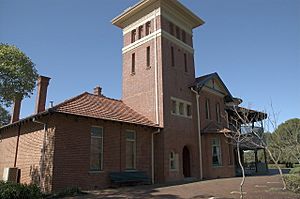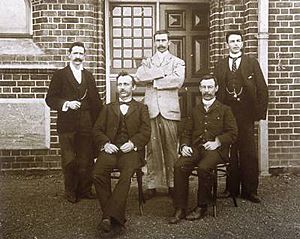Perth Observatory facts for kids
The Perth Observatory is the name of two special places in Western Australia where people study the stars and planets. The first observatory was built in 1896 in West Perth, on Mount Eliza. It had a great view of the city of Perth.
But as Perth grew, the city lights made it harder to see the stars. So, in 1965, the observatory moved to a new, darker spot in Bickley. Sometimes, people call this new place the Bickley Observatory.
Contents
History of the Perth Observatory
The First Observatory in Perth
The original Perth Observatory was built in 1896 and officially opened in 1900. John Forrest, the first premier of Western Australia, opened it. This observatory was very important for keeping the correct time for Western Australia. It also collected weather information.
The main dome of the observatory was taken down in the 1960s. This happened when the observatory moved to its new location. The old chief astronomer's house is still there today.
Early Government Astronomers
William Ernest Cooke
William Ernest Cooke was the first Western Australian Government Astronomer. He started in 1896. His first job was to figure out the exact location (latitude and longitude) of the colony. He also made sure the time was much more accurate. Before he arrived, clocks could be wrong by up to half an hour! A cannon on the grounds used to fire every day to announce the correct time.
Harold Burnham Curlewis
Cooke's replacement was Harold Curlewis. He thought the observatory's location was excellent for astronomy. He said that even with the city growing, the nearby King's Park helped keep the viewing conditions good.
Curlewis and the WA Border
Curlewis also helped to mark the exact borders of Western Australia. In 1920 and 1921, he worked with the South Australian Government Astronomer. They used new technology like wireless radio signals to find precise spots for the border lines. These efforts helped create Surveyor Generals Corner later on.
Hyman Solomon Spigl
Hyman Solomon Spigl was the Government Astronomer from 1940 to 1962. He worked hard to rebuild the observatory after the war. He improved the time service and earthquake monitoring. He also started looking for a new location for the observatory. This was because a plan from 1955 suggested moving it.
John Bertrand Harris
John Bertrand Harris became the Government Astronomer in 1962. He oversaw the big move of the Perth Observatory to its new site in Bickley. This new location was about 24 kilometers east of Perth. Construction started in 1964, and staff moved in by the end of 1965.
In 1967, Harris helped install a special telescope called a meridian circle telescope. This was part of an international project to map stars in the Southern Hemisphere. He also worked with the University of Western Australia to install another telescope for students and staff.
Harris also brought the astrographic telescope to the new site. This telescope took photos of the sky to study how stars move over time. In 1968, the Lowell Observatory from the USA placed a 24-inch telescope at Perth. This telescope was used to take pictures of planets like Mars, Jupiter, and Venus.
Harris was also important for restarting public tours in 1966. He made sure the observatory continued to share information with the people of Western Australia.
Dr Iwan (Ivan) Nikoloff
Dr Iwan Nikoloff became the Government Astronomer in 1979. He had been working at the observatory since 1964. He helped set up the new observatory in Bickley using his surveying skills.
Nikoloff continued the important work of mapping stars. He led the team that created the Perth 75 star catalogue. This catalogue provided valuable information for astronomers around the world. He also kept the observatory's public tours and information services going. He retired in 1985.
Perth Observatory Directors
After Dr Nikoloff retired, the main leader of the Perth Observatory was called the "Director" instead of "Government Astronomer." This change happened because the old title seemed a bit old-fashioned.
Michael Philip Candy
Michael Philip Candy became the first Director of the Perth Observatory. He was very interested in comets. He quickly made the Perth Observatory one of the best in the world for studying comets in the Southern Hemisphere.
Under his leadership, the observatory discovered over 100 new asteroids. They also made many observations of minor planets. In 1986-1987, when Halley's Comet returned, the Perth Observatory made 10% of all the Earth-based observations of the comet. This was the largest contribution in the world!
Mr. Candy retired in 1993. An asteroid, 3015 Candy, was named in his honor in 1980.
James D Biggs and Ralph Martin
Dr James D Biggs was the Director from 1994 to 2010. After he left, Ralph Martin became the acting Director. In 2013, the WA Government decided to stop all research programs at the observatory. It would only be open for tours. Ralph Martin and the remaining staff chose to leave their jobs.
Earthquake Records
The Perth Observatory also used to record earthquakes. From 1923 to 1959, a special machine called a seismograph was used. After 1959, the earthquake monitoring moved to the Mundaring Geophysical Observatory.
The New Observatory at Bickley
In the 1960s, the bright lights from the city of Perth made it hard to see the stars clearly. Also, the land where the old observatory stood was needed for new government buildings. So, the observatory moved to its current home in Bickley, near Mount Gungin. The new observatory cost $600,000 to build and opened on September 30, 1966.
Recent History
The observatory has faced challenges, including attempts by the State Government to close it. But public support from scientists and amateur astronomers helped keep it open.
Since July 2015, the Perth Observatory Volunteer Group has been running the observatory. They work with the Department of Parks and Wildlife to keep this important place going.
Centenary in 1996
In 1996, the observatory celebrated 100 years since it was founded. It was then moved to the Department of Conservation and Land Management, which is now part of the Department of Parks and Wildlife (Western Australia).
Bickley Observatory Heritage Listed
In 2005, the Bickley site was recognized as a heritage place. It is Australia's oldest continuously operating observatory. It is also Australia's only remaining State Government-operated astronomical observatory.
Publications
The observatory used to publish the Western Australian astronomy almanac. This guide helped people learn about the night sky. It was preceded by other publications like Astronomical Data and the Astronomical Handbook.
Perth Observatory Today
The Minor Planet Center has given credit to Perth Observatory for discovering 29 minor planets between 1970 and 1999.
Even though research programs were stopped in 2013, the Perth Observatory is still very active. Since July 1, 2015, the Perth Observatory Volunteer Group has been managing it. Only three part-time staff and almost 120 dedicated volunteers keep it running. They work hard to make sure it remains a place for science and heritage education.
Each year, the observatory hosts over 200 events, attracting more than 10,000 visitors. They also hold star-viewing events in remote parts of Western Australia. This helps everyone in WA, no matter where they live, to explore the universe. The volunteers contribute over 18,000 hours each year. This includes 6,000 hours for public events and 12,000 hours for training, preserving heritage, and maintaining the site.
Honors
The asteroid 3953 Perth was named in honor of the observatory.
|
Publication
- Western Australian astronomy almanac. Bickley, W.A. Perth Observatory. ISBN: 0-9581963-6-2 (2007 edition)



